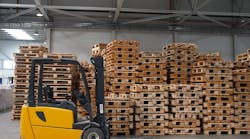When you think about forklift safety, it’s the operational aspects that typically command attention: driving at a safe speed, minding maximum load capacities, awareness of nearly foot traffic, etc. However, forklift maintenance – and how often your company conducts regular inspections – is one area where non-compliance occurs.
The U.S. Occupational Safety & Health Administration (OSHA) requires regular inspections of all powered industrial trucks. But many safety supervisors, foremen and others involved with workplace safety want to know how many times per week should inspections happen?
Forklift maintenance – it’s the one part of powered industrial truck safety that many CEOs, safety supervisors and employees THINK they can’t live with. The truth is, you really can’t live without it.
Forklift maintenance is one of the most critical – and often overlooked – aspects of total forklift safety. In fact, OSHA requires vigilant daily inspections of all forklifts, including warehouse lifts, rough terrain forklifts, narrow aisle lifts, pallet jacks, and more.
Three key OSHA guidelines lay out the framework for a productive, positively safe forklift maintenance schedule:
- 29 CFR 1910.178(p)(1) – employees and employers must never knowingly drive a forklift that is known to be unsafe…in other words, a forklift that hasn’t undergone a recent inspection.
- 29 CFR 1910.178(q)(1) – all powered industrial trucks should be removed from active use, and repairs are required to be undertaken by trained personnel. Any forklift maintenance should not be attempted by untrained employees.
- 29 CFR 1910.178(q)(1) – forklifts should be maintained to promote a clean condition, with no noticeable grease, dust, oil and other substances.
Individually, each guideline provides a crucial piece of the overall forklift maintenance puzzle. Collectively, they form the backbone of any sensible, well-planned, sustainable forklift maintenance program.
These guidelines help create a safer working environment for everyone involved with forklift use, including those you wouldn’t think would be impacted by unsafe forklifts – namely, pedestrians passing through an active work area. Some are common sense safety measures, while others are more complex in terms of detail and execution. Taken together, they’re the foundation for regular, reliable inspections for your entire powered industrial truck fleet.
Per OSHA rules, forklifts should be inspected daily – at a bare minimum, at least 3-4 times per week (if the forklift isn’t used every day). In practical terms, how does this translate into a workable forklift maintenance plan for your enterprise?
1. Monitor all critical forklift operating systems, including the brakes, steering controls, backup alarms, safety mechanisms, tilt control, and more. General rule of thumb: if it moves or impacts safety in any way, it requires constant attention. Safety on the job often begins with thorough inspections BEFORE the job even starts.
2. Ensure your maintenance personnel and employees always conduct a visual pre-check (mechanical inspections, harnesses, etc.) and operational pre-check (brakes, safety signals, cockpit controls, etc.) before each shift. FLC has a handy forklift inspection checklist to help your company stay on track with OSHA maintenance requirements.
3. Encourage everyone to get involved with forklift maintenance. Have your drivers report any operational abnormalities or defects. Make sure your maintenance personnel and forklift operators are in regular communication.
4. Offer incentives for regular maintenance activities. Think gift cards for no skipped maintenance days, or an extra vacation day for fixing a problem that may have caused a major accident or injury. A thorough, well-designed maintenance plan backed by a worthwhile incentive plan automatically draws in more people than you’d think. Yes, it’s true – maintenance can be (quite literally) rewarding.
5. Post your general maintenance requirements where everyone can see them. This is helpful for non-maintenance personnel. For example, forklift operators get a general idea of what checks entail comprehensive maintenance procedures. This may help them identify small issues before they become serious ones.
With the guidelines provided by OSHA and your own requirements – above and beyond minimum OSHA maintenance activities – you’ll soon discover that regular maintenance is easier and more achievable than you think. Regular forklift is the smart, sensible, SAFE thing to do for your entire enterprise. Don’t wait for an OSHA audit to get serious with your forklift maintenance plan.
Tom Wilkerson is the CEO of ForkliftCertification.com (FLC).
